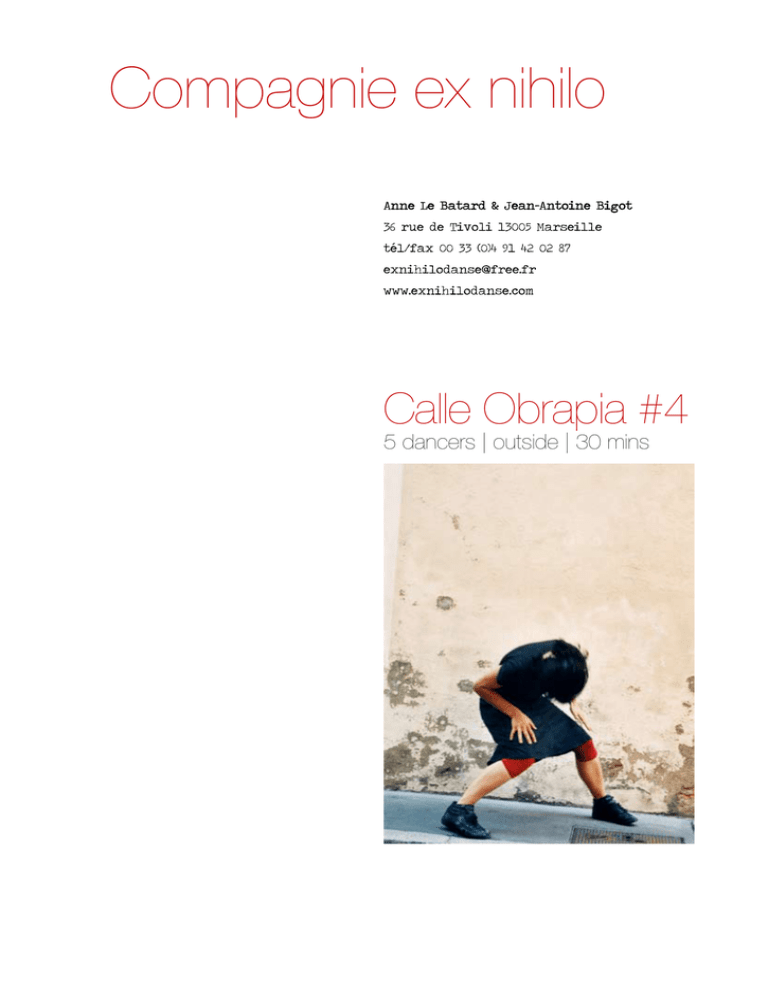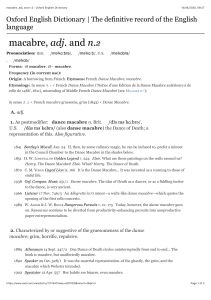Calleanglaisespagnol..
Anuncio

Compagnie ex nihilo Calle Obrapia #4 5 dancers | outside | 30 mins The company Ex Nihilo is a company that we direct around a shared desire: to regard public space as the work place and the site for our shows. Public space that we understand in all its richness and dimensions: spatial, historical, social, poetic… public space, quite simply as the other place for art? Each of our creations is envisaged in situ and is strongly linked to the space in which it will be shown. The specific history of the site, the relationships that exist there, its atmosphere, all this “enriches” our writings, nourish the scenario and the set design of each one of them. We call these encounters with such places: Amalgame(s). Both performances and research, impregnated with feeling - ‘amal ‘al gam, the work of union, in Arabic – some of these encounters have formed shows that now figure in the company’s repertoire and are rebuilt every time they are shown… Others remain performances linked uniquely to a specific location. A street, a wall for La plus belle heure, a beach at low tide for Loin de Là, a village square for Salida, the district of Belsunce for Projet Passants, the Frioul Islands off the coast of Marseilles for Quarantaine, the crowd and the individual for Trajets de vie, Trajets de ville… For every new creation we wonder about the relationship with the public, playing on the numerous details of proximity and of distance, attempting upheaval always to completely change our position, that of the spectator and his way of seeing at the same time. But we like also to cross over some boundaries and continue our research on stage – inside: the moving from one place for art to another, the interplay between the public arena and the stage, is a distinctive feature of our approach. The dance of Ex Nihilo develops the relationship between the dancers and their awareness of each other. It is a physical dance, reactionary, spontaneous, but written with purpose – logical. Movement is declared as being a way of “taking” a territory, or rather, the dancers borrow a space for the duration of the work or a show – a light, ephemeral appropriation which never excludes the “other”, the passer-by, the spectator, the citizen… Ubicado en Marsella, Ex Nihilo es una compania coreografica llevada por Anne Le Batard y Jean Antoine Bigot. Tiene la voluntad de utilizar el espacio publico como espacio de trabajo y de representacion. Las relaciones entre los hombres, la historia y la arquitectura de un lugar forman los limites de sus creaciones. Ex nihilo privilegia el contacto, la escucha, una danza reactiva a un entorno, espontanea; unos movimientos que toman posesion de un teritorio. Una calle, una pared para «La plus belle heure», una playa con bajamar «Loin de Là», la plaza de un pueblo para «Salida», el barrio de Belsunce en Marsella «Projet Passants», una callejuela Anne Le Batard and Jean-Antoine Bigot para «Calle Obrapia #4» o aun el vestigio de un antiguo hospital para Quarantaine… para cada nueva creacion, Ex Nihilo interoga su relacion con el publico, jugando con las distancias y con la profundidad o bien sobre la promiscuidad… 1 Calle Obrapia #4 © G. Mathieu A narrow street, its pavements, the walls of its houses: a space to discover, to take over. Three women and two men take possession of a space. Each one has their own history, their own identity, the need for recognition. Wandering, waiting and hope are some of the many postures and feelings that pass between them. They dance with the walls, the ground, the pavements. Bodies cross over, interlace, collide, embrace, speak to each other. Are they passing by, in transit or in exile? From time to time some snatches of music break the silence and the voices of transistor radios allow us to hear bits and pieces of current affairs, music and multi-coloured voices. Una calle estrecha, con sus aceras, con las paredes de las casas: un espacio para descubrir, para hacerselo suyo. Tres mujeres y dos hombres tienen que apropriarse de un lugar. Cada uno tiene su historia, su identidad, la necesidad de reconocimiento. La busqueda, la espera, la esperanza son actitudes y sentimientos que los atraviesan. Estan aqui temporalemente, en transito, en exilio ? De vez en cuando, algunos aires de musica rompen con el silencio y la presencia de algunas radios transistores nos dejan recaudar algunos fragmentos de la actualidad, de musica del cotidiano formando asi los principales elementos sonoros de este trozo de vida. 2 Some notes on the company Trajets de Vie Trajets de Ville, Marrakeck, Paris, Séoul © Martine Derain Ex Nihilo is a contemporary dance company created in 1993, that chooses: - To create choreographies in situ outdoor (public places or natural spaces) and indoor. - To create with the others (musicians, film-makers, visual artists, video directors…). - To develop specific projects in connection with a structure, a territory, a public. - To emphasize the broadcasting of its work by maintaining an alive repertoire: an average of 50 dates a year (half on the last creation Trajets de Vie Trajets de Ville, other half on the repertoire, consisted today of 8 rooms plays among which very active 6). - To pass on its research with all the public: Master-Class in Seoul Art Center; formation of 3rd cycle at the University of Lyon: workshops Body/movement with the cooperation of ECM/ZINC within the framework of the network RAMI; meetings around the creation in public place (Metropolis/Copenhagen, HorsLesMurs in Paris, professional artistic Meetings of Toulon) and of co-creations abroad (French-Korean creation, cooperation for the tours abroad). - To pass on its practice: educational actions in schools and high schools (General Council 13 and Drac Haute-Normandie); training courses within the framework of the in-service training of the Department of Education; Experimental School of Dance in Salzburg; daily Training of the company opened to the public during every residence of creation and in a more regular way in Marseille in the Studio Kelemenis… Ex Nihilo is supported for its creations and programmed by: · the institutional dance network: - on a regional level: Dansem (Marseille 1999, 2001 & 2003 ); Festival de Marseille 2008; Théâtre en Dracénie 2007; Danse en Avril in Aubagne (2007 & 2009); Ballet National de Marseille 2010… - in France: Quartz, scène nationale de Brest (Festival des Antipodes 2004 & 2008); Pôle Sud, Nouvelles Strasbourg Danse 2008; Seine de Danse 2009; Le Temps d’aimer in Biarritz 2009… - international: Festival Tanzdanzen in Greiswald, Germany; Santos and Sao Paulo (Brazil) by the Sesc network; Festivals of Sabadell and Terrassa in Spain… . by festivals and multidisciplinary structures: - on a regional level: Festival Pazzapas/Lieux Publics-Le Merlan in Marseille; 3 Bis F in Aix-en-Provence… - in France: Scènes Nationales Le Fanal-St Nazaire, Le Cratère-Alès… - international: network of the Villes qui dansent (Corpi Urbani/Gênes, Eupen-Liège in Belgium, Ciudad in movimiento/ 3 Havana Cuba, Greenwich and Docksland Festival/Londres, Mes de Danza/Seville, Dies de Danza/Barcelona, Mudanzas/ Carthagène festival); Huis a/d Werf/Utrecht in the Netherlands; festival of Bat Yam (Israel) … . and by the network of «arts de la rue»: - region : Les Siacreries in Carros; Festival Chaud Dehors and Danse en Avril in Aubagne; L’année des 13 Lunes (CG13Lieux Publics); La Folle Histoire de la rue (CG13-Karwan); Lieux Publics-Festival Small is beautiful… - in France: Main street festivals as Chalon dans la rue; Les Tombées de la Nuit in Rennes; Vivacité in Sotteville-lèsRouen; Festival Furies in Chalon en Champagne; Danse en Ville in Amiens; Aurillac… - international: IN SITU network (European support for the creation in public space directed by Lieux Publics (of which are partner: Merchant City Festival-GB; Strada-Autriche, TAC-Valladolid; Atelier 231 in Sotteville-lès-Rouen and Oerol Festival in tne Netherlands) for the creation 2007; Theater Op de Markt in Belgium; Hanmadang Festival, South Korea; Awaln’art festival in Marrakesh in 2008; Tarrega festival in Spain… • Collaborations/Co-productions Ex Nihilo is also supported for some of its creations by two Centres Chorégraphiques Nationaux (Rilleux-la-Pape/Maguy Marin on 2004 and 2006, Caen/Fattoumi-Lamoureux 2006 with Accueils-Studio); by the Company Kelemenis («Artists’ Question, questions of dance», rehearsals, training and for the creation 2009, by the National Ballet of Marseille and Frappaz studios. · Ex Nihilo was associated with the artist studio The Company (visual arts) for a project on the district Belsunce (20012002). · Ex Nihilo was also «associated artist» of Atelier 231 from 2005 till 2006. · The company was supported for the production of its creations by the network of the National Centres of «arts de la rue» (Le Fourneau in Brest, Pronomades/Encausses-les-thermes, L’abattoir/Châlon-sur-saône, Atelier 231/Sotteville-lèsrouen, L’Usine/Tournefeuille) and for the creation 2009, by Studios Frappaz in Villeurbanne. · For its international tours, the company is supported by CULTURESFRANCE and the cultural services of Embassies (Korea, Morocco, Poland, Brazil, Havana). • Public partners Ex Nihilo is subsidized by the Ministry of Culture and Communication/DRAC-PACA within the framework of the subsidized companies, the City of Marseille, the General Council of Bouches-du-Rhône, the Region Provence-Alpes-Côte d’Azur, the ADAMI and the SACD. • Filmography Rue des Petites Maries, Laurence Rebouillon | super 8 | 12’ | 2004 West Point, Laurence Rebouillon | Super 8 et 16 mm | 57’ | 2008 TVTV, Jean-Antoine Bigot/Martine Derain/Anne Le Batard | vidéo | 28’ | 2009 Quarantaine au Frioul Salida, Par les Villages Loin de là, à Port Saint Louis 4 The choreographers Assemblements, by Anne Le Batard et Jean-Antoine Bigot, 2009 © Martine Derain Anne Le Batard She developed her through the various courses followed, notably with Hervé Diasnas, Jackie Taffanel, Myriam Berns, Frey Faust, Gérard Gourdot and Hubert Godart in kinésiologie. Dancer with Karin Vyncke’s company in Brussells from 1996 to 1999, and in L est là by Georges Appaix, with La Liseuse company. She co-founded Ex Nihilo in 1993, and took over the artistic direction with Jean-Antoine Bigot in 2000. It is for this unique form of dance in relation to natural or public spaces that she has been invited to collaborate with other companies, such as Ilotopie for their creation Narcisse guette or with ECM/Zinc/Friche de la Belle de mai, where shes’ co-directing a workshop questioning the body, multi-media and performance. Obtaining the certification to teach contemporary dance in 1995, she began developing artistic workshops in schools and universities, and elsewhere for amateurs and professionals. Working in close collaboration with JeanAntoine Bigot, she runs various workshops, courses, training sessions that relate the ‘dance’ to the public space, the relationship with the environment whatever it might be and the relationship to the ‘other’, dancer/partner or public/passer-by. Jean-Antoine Bigot He discovered dance while studying at UFRAPS Paris V thanks to Françoise Lamouche and Claude Philippi and continued his training following courses led by Pierre Doussaint, Hervé Diasnas, Catherine Diverrès, Thierry Baë, Bernardo Montet, Jean Gaudin, the company Roc in Linchen, Claude Brumachon and Jacques Patarozzi. Le Vide, the first solo he created, selected for the Val de Marne Biennial. In 1992 he created a duo with Bruno Pradet. From this collaboration was born the Pied Gauche group. In 1997 he joined Ex Nihilo for several of their projects and became the artistic director of the company with Anne Le Batard in 2000. Alongside these personal projects he continues his career as a dancer, from 1994 to 1997 with Karin Vyncke, from 1993 to 2001 with Hela Fattoumi and Eric Lamoureux. He began to teach dance within the framework of the residences of the companies Fattoumi-Lamoureux and Le Pied Gauche in secondary schools and universities as well as with amateur and professional dancers. His career as a dancer, within the framework of the courses run with Ex Nihilo which accentuate the importance of the presence, the density and the interpretative skills of the dancer, has led him to develop the physical aspects of dance as well as the relationships within a duo or within a group. 5

